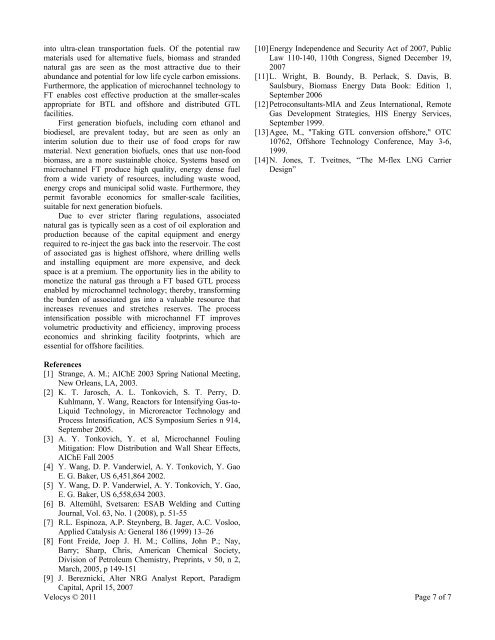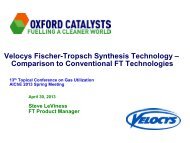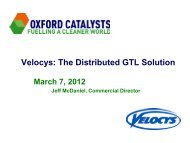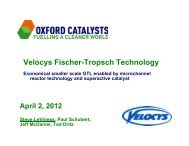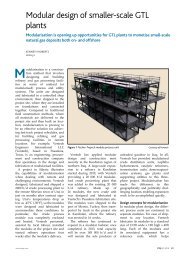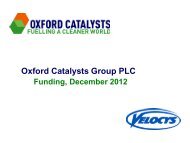Improved Fischer-Tropsch Economics Enabled by Microchannel ...
Improved Fischer-Tropsch Economics Enabled by Microchannel ...
Improved Fischer-Tropsch Economics Enabled by Microchannel ...
Create successful ePaper yourself
Turn your PDF publications into a flip-book with our unique Google optimized e-Paper software.
into ultra-clean transportation fuels. Of the potential raw<br />
materials used for alternative fuels, biomass and stranded<br />
natural gas are seen as the most attractive due to their<br />
abundance and potential for low life cycle carbon emissions.<br />
Furthermore, the application of microchannel technology to<br />
FT enables cost effective production at the smaller-scales<br />
appropriate for BTL and offshore and distributed GTL<br />
facilities.<br />
First generation biofuels, including corn ethanol and<br />
biodiesel, are prevalent today, but are seen as only an<br />
interim solution due to their use of food crops for raw<br />
material. Next generation biofuels, ones that use non-food<br />
biomass, are a more sustainable choice. Systems based on<br />
microchannel FT produce high quality, energy dense fuel<br />
from a wide variety of resources, including waste wood,<br />
energy crops and municipal solid waste. Furthermore, they<br />
permit favorable economics for smaller-scale facilities,<br />
suitable for next generation biofuels.<br />
Due to ever stricter flaring regulations, associated<br />
natural gas is typically seen as a cost of oil exploration and<br />
production because of the capital equipment and energy<br />
required to re-inject the gas back into the reservoir. The cost<br />
of associated gas is highest offshore, where drilling wells<br />
and installing equipment are more expensive, and deck<br />
space is at a premium. The opportunity lies in the ability to<br />
monetize the natural gas through a FT based GTL process<br />
enabled <strong>by</strong> microchannel technology; there<strong>by</strong>, transforming<br />
the burden of associated gas into a valuable resource that<br />
increases revenues and stretches reserves. The process<br />
intensification possible with microchannel FT improves<br />
volumetric productivity and efficiency, improving process<br />
economics and shrinking facility footprints, which are<br />
essential for offshore facilities.<br />
[10] Energy Independence and Security Act of 2007, Public<br />
Law 110-140, 110th Congress, Signed December 19,<br />
2007<br />
[11] L. Wright, B. Boundy, B. Perlack, S. Davis, B.<br />
Saulsbury, Biomass Energy Data Book: Edition 1,<br />
September 2006<br />
[12] Petroconsultants-MIA and Zeus International, Remote<br />
Gas Development Strategies, HIS Energy Services,<br />
September 1999.<br />
[13] Agee, M., "Taking GTL conversion offshore," OTC<br />
10762, Offshore Technology Conference, May 3-6,<br />
1999.<br />
[14] N. Jones, T. Tveitnes, “The M-flex LNG Carrier<br />
Design”<br />
References<br />
[1] Strange, A. M.; AIChE 2003 Spring National Meeting,<br />
New Orleans, LA, 2003.<br />
[2] K. T. Jarosch, A. L. Tonkovich, S. T. Perry, D.<br />
Kuhlmann, Y. Wang, Reactors for Intensifying Gas-to-<br />
Liquid Technology, in Microreactor Technology and<br />
Process Intensification, ACS Symposium Series n 914,<br />
September 2005.<br />
[3] A. Y. Tonkovich, Y. et al, <strong>Microchannel</strong> Fouling<br />
Mitigation: Flow Distribution and Wall Shear Effects,<br />
AIChE Fall 2005<br />
[4] Y. Wang, D. P. Vanderwiel, A. Y. Tonkovich, Y. Gao<br />
E. G. Baker, US 6,451,864 2002.<br />
[5] Y. Wang, D. P. Vanderwiel, A. Y. Tonkovich, Y. Gao,<br />
E. G. Baker, US 6,558,634 2003.<br />
[6] B. Altemühl, Svetsaren: ESAB Welding and Cutting<br />
Journal, Vol. 63, No. 1 (2008), p. 51-55<br />
[7] R.L. Espinoza, A.P. Steynberg, B. Jager, A.C. Vosloo,<br />
Applied Catalysis A: General 186 (1999) 13–26<br />
[8] Font Freide, Joep J. H. M.; Collins, John P.; Nay,<br />
Barry; Sharp, Chris, American Chemical Society,<br />
Division of Petroleum Chemistry, Preprints, v 50, n 2,<br />
March, 2005, p 149-151<br />
[9] J. Bereznicki, Alter NRG Analyst Report, Paradigm<br />
Capital, April 15, 2007<br />
Velocys © 2011 Page 7 of 7


